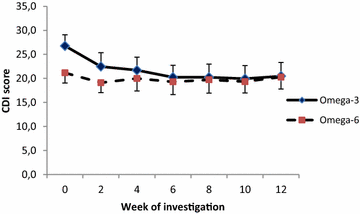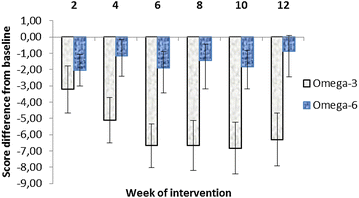Emulsified omega-3 fatty-acids modulate the symptoms of depressive disorder in children and adolescents: a pilot study
- PMID: 28690672
- PMCID: PMC5497377
- DOI: 10.1186/s13034-017-0167-2
Emulsified omega-3 fatty-acids modulate the symptoms of depressive disorder in children and adolescents: a pilot study
Abstract
Background: The prevalence of mood disorders in children is a growing global concern. Omega-3 fatty acids (FA) are emerging as a promising adjuvant therapy for depressive disorder (DD) in paediatric patients. The primary objective of this pilot, single-centre, randomized, double-blind controlled study was to compare the efficacy of an Omega-3 FA fish oil emulsion with a control oil emulsion alongside standard treatment for depressive symptoms in children and adolescents suffering from depressive disorder (DD) and mixed anxiety depressive disorder (MADD).
Methods: 38 children (12 patients were treated and diagnosed for at least 1 month before enrolment, 26 patients were first-time diagnosed as DD) aged 11-17 years were randomised 1:1 to the intervention (Omega-3 FA, 19 patients) or active comparator (Omega-6 FA, 19 patients) groups. Children's depression inventory (CDI) ratings were performed at baseline, every 2 weeks for a 12-week intervention period and at 4-week post-intervention. 35 patients (17 in Omega-3 and 18 in Omega-6 groups) who completed the whole intervention period were evaluated. Patients from Omega-3 group were stratified according to diagnosis into two subgroups (DD-10/17 and mixed anxiety depressive disorder (MADD)-7/17 patients) and in the Omega-6 group into DD-10/18 and MADD-8/18 patients. Groups were evaluated separately. Differences between-groups were tested with the Student´s t test or non-parametric Mann-Whitney U test. Two-way ANOVA with repeated measures and Friedman test were used to analyse the Treatment effect for response in CDI score. p < 0.05 was considered significant in all statistical analyses.
Results: Significant reductions in CDI scores in 35 analysed patients who completed 12 weeks intervention were observed after 12 weeks of intervention only in the Omega-3 group (p = 0.034). After stratification to depressive disorder and mixed anxiety depressive disorder subgroups, the DD subgroup receiving the Omega-3 FA fish oil showed statistically greater improvement (score reduction after 8 week treatment of -9.1 CDI, p = 0.0001) when compared to the MADD subgroup (score reduction after 8 week treatment -4.24 CDI, p = 0.271).
Conclusions: CDI scores were reduced in the Omega-3 group and the depression subgroup had greater improvement than the mixed depressive/anxiety group. An Omega-3 fatty acid rich fish oil emulsion may be an effective adjuvant supplement during the treatment of depressive disorders in children. Trial registration ISRCTN81655012.
Figures



Similar articles
-
Omega-3 fatty-acids modulate symptoms of depressive disorder, serum levels of omega-3 fatty acids and omega-6/omega-3 ratio in children. A randomized, double-blind and controlled trial.Psychiatry Res. 2020 May;287:112911. doi: 10.1016/j.psychres.2020.112911. Epub 2020 Mar 7. Psychiatry Res. 2020. PMID: 32179212 Clinical Trial.
-
Lipid Profile, Lipoprotein Subfractions, and Fluidity of Membranes in Children and Adolescents with Depressive Disorder: Effect of Omega-3 Fatty Acids in a Double-Blind Randomized Controlled Study.Biomolecules. 2020 Oct 8;10(10):1427. doi: 10.3390/biom10101427. Biomolecules. 2020. PMID: 33050072 Free PMC article. Clinical Trial.
-
The Effect of Omega-3 Fatty Acids on Thromboxane, Brain-Derived Neurotrophic Factor, Homocysteine, and Vitamin D in Depressive Children and Adolescents: Randomized Controlled Trial.Nutrients. 2021 Mar 27;13(4):1095. doi: 10.3390/nu13041095. Nutrients. 2021. PMID: 33801688 Free PMC article. Clinical Trial.
-
Novel Augmentation Strategies in Major Depression.Dan Med J. 2017 Apr;64(4):B5338. Dan Med J. 2017. PMID: 28385173 Review.
-
ECNP consensus meeting. Bipolar depression. Nice, March 2007.Eur Neuropsychopharmacol. 2008 Jul;18(7):535-49. doi: 10.1016/j.euroneuro.2008.03.003. Epub 2008 May 23. Eur Neuropsychopharmacol. 2008. PMID: 18501566 Review.
Cited by
-
Omega-3 Fatty Acids as a Treatment for Pediatric Depression. A Phase III, 36 Weeks, Multi-Center, Double-Blind, Placebo-Controlled Randomized Superiority Study.Front Psychiatry. 2019 Nov 27;10:863. doi: 10.3389/fpsyt.2019.00863. eCollection 2019. Front Psychiatry. 2019. PMID: 31827448 Free PMC article.
-
Effects of Fish Oil Monotherapy on Depression and Prefrontal Neurochemistry in Adolescents at High Risk for Bipolar I Disorder: A 12-Week Placebo-Controlled Proton Magnetic Resonance Spectroscopy Trial.J Child Adolesc Psychopharmacol. 2020 Jun;30(5):293-305. doi: 10.1089/cap.2019.0124. Epub 2020 Mar 11. J Child Adolesc Psychopharmacol. 2020. PMID: 32167792 Free PMC article. Clinical Trial.
-
Effects of Omega-3 PUFAs on lipid profiles and antioxidant response in depressed adolescents: A metabolomic and lipidomic study.Redox Biol. 2025 May;82:103617. doi: 10.1016/j.redox.2025.103617. Epub 2025 Mar 25. Redox Biol. 2025. PMID: 40158256 Free PMC article. Clinical Trial.
-
Meals, Microbiota and Mental Health in Children and Adolescents (MMM-Study): A protocol for an observational longitudinal case-control study.PLoS One. 2022 Sep 1;17(9):e0273855. doi: 10.1371/journal.pone.0273855. eCollection 2022. PLoS One. 2022. PMID: 36048886 Free PMC article.
-
[A novel mutation in the ETFDH gene of an infant with multiple acyl-CoA dehydrogenase deficiency].Zhongguo Dang Dai Er Ke Za Zhi. 2018 Jul;20(7):529-533. doi: 10.7499/j.issn.1008-8830.2018.07.003. Zhongguo Dang Dai Er Ke Za Zhi. 2018. PMID: 30022752 Free PMC article. Chinese.
References
-
- Costello J, Erkanli A, Angold A. Is there an epidemic of child or adolescent depression? J Child Psychol Psychiatry. 2006;47:1263–1271. - PubMed
-
- Coghill D, Bonnar S, Duke S, Graham J, Seth S. Child and adolescent psychiatry. Oxford: Oxford University Press; 2009. ISBN: 978-0-19-923499-8.
-
- Colin A, Reggers J, Castronovo V, Ansseau M. Lipds, depression and suicide. Encephale. 2003;29:49–58. - PubMed
LinkOut - more resources
Full Text Sources
Other Literature Sources

